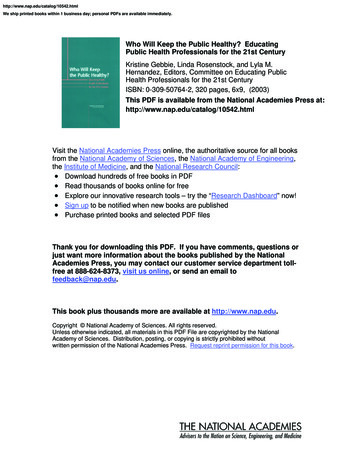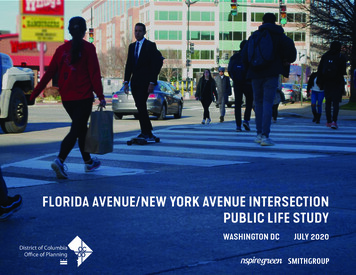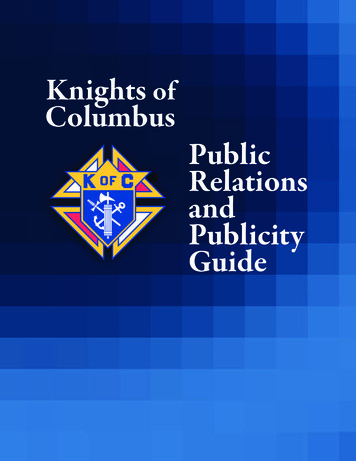
Transcription
http://www.nap.edu/catalog/10542.htmlWe ship printed books within 1 business day; personal PDFs are available immediately.Who Will Keep the Public Healthy? EducatingPublic Health Professionals for the 21st CenturyKristine Gebbie, Linda Rosenstock, and Lyla M.Hernandez, Editors, Committee on Educating PublicHealth Professionals for the 21st CenturyISBN: 0-309-50764-2, 320 pages, 6x9, (2003)This PDF is available from the National Academies Press at:http://www.nap.edu/catalog/10542.htmlVisit the National Academies Press online, the authoritative source for all booksfrom the National Academy of Sciences, the National Academy of Engineering,the Institute of Medicine, and the National Research Council: Download hundreds of free books in PDF Read thousands of books online for free Explore our innovative research tools – try the “Research Dashboard” now! Sign up to be notified when new books are published Purchase printed books and selected PDF filesThank you for downloading this PDF. If you have comments, questions orjust want more information about the books published by the NationalAcademies Press, you may contact our customer service department tollfree at 888-624-8373, visit us online, or send an email tofeedback@nap.edu.This book plus thousands more are available at http://www.nap.edu.Copyright National Academy of Sciences. All rights reserved.Unless otherwise indicated, all materials in this PDF File are copyrighted by the NationalAcademy of Sciences. Distribution, posting, or copying is strictly prohibited withoutwritten permission of the National Academies Press. Request reprint permission for this book.
Who Will Keep the Public Healthy? Educating Public Health Professionals for the 21st yMany achievements in reducing mortality and morbidity during thepast century can be traced directly to public health initiatives. The extent towhich we are able to make additional improvements in the health of thepublic depends, in large part, upon the quality and preparedness of thepublic health workforce, which is, in turn, dependent upon the relevanceand quality of its education and training. This report examines an essentialcomponent of the public health workforce—public health professionals.COMMITTEE CHARGEThe charge of this committee was to develop a framework for how,over the next 5 to 10 years, education, training, and research in schools ofpublic health could be strengthened to meet the needs of future publichealth professionals to improve population-level health. The committeealso was asked to develop recommendations for overall improvements inpublic health professional education, training, research, and leadership. Awide range of institutional settings, including not only schools of publichealth but also degree-granting programs in public health, medical schools,schools of nursing, other professional schools (e.g., law), and local, state,and federal public health agencies, play important roles in public healtheducation, training, research, and leadership development. This report presents conclusions and recommendations for each of these institutional settings that are directed toward improving the future of public health professional education in the United States.3Copyright National Academy of Sciences. All rights reserved.
Who Will Keep the Public Healthy? Educating Public Health Professionals for the 21st Centuryhttp://www.nap.edu/catalog/10542.html4WHO WILL KEEP THE PUBLIC HEALTHY?DEFINITIONPublic health professionals receive education and training in a widerange of disciplines, come from a variety of professions, work in manytypes of settings, and are engaged in numerous kinds of activities. Onething public health professionals have in common is a focus on populationlevel health. For purposes of this study, therefore, the committee developedthe following definition: A public health professional is a person educated inpublic health or a related discipline who is employed to improve health through apopulation focus. Nearly all public health professionals encompassed by thisdefinition have earned at least a baccalaureate degree.CHALLENGESAs we begin the 21st century, public health professionals are facedwith major challenges including globalization, scientific and technological advances, and demographic changes. The health of the U.S. population is increasingly affected by globalization and its accompanyingenvironmental changes. Increased travel, trade, economic growth, anddiffusion of technology have been accompanied by negative social andenvironmental conditions, a greater disparity between rich and poor, environmental degradation, and food security issues. There is increasingcause for concern about drug-resistant strains of emerging and re-emerging diseases (e.g., HIV/AIDS, tuberculosis, hepatitis B, malaria, cholera,diptheria, and Ebola). Along with the transmission of microbes and viruses, the increase in international trade is fostering the distribution ofproducts associated with major health risks, for example, alcohol andtobacco.Major challenges related to advances in science and medical technologies include important ethical, legal, and social questions. Communication technology, for example, offers increased opportunity for dissemination of health information but also requires response to the misleadingor incorrect information spread through the use of this same technology.Public health informatics (i.e., the systematic application of informationand computer science and technology to public health practice, research,and learning [Yasnoff et al., 2000]) offers great potential for improvingour public health surveillance capacity and response but is accompaniedby concerns regarding confidentiality and security of the information systems. Genomics holds the promise of helping us understand the role thatgenetic factors play in morbidity and mortality in the United States. However, we will need to ensure that individuals with certain genetic traitsand predispositions are not discriminated against in the workplace or inobtaining insurance. While scientific advances in the biomedical field haveimproved the health of the public, about half of all causes of mortality inCopyright National Academy of Sciences. All rights reserved.
Who Will Keep the Public Healthy? Educating Public Health Professionals for the 21st RYthe United States are linked to social and behavioral factors and accidents(McGinnis and Foege, 1993). However, the vast majority of the nation’shealth research resources have been directed toward biomedical research,with comparatively few resources devoted to supporting health researchon social and behavioral determinants of health (IOM, 2000).Major demographic transformations are taking place in the UnitedStates and around the world that also present public health with newchallenges. The population is aging, and this aging is accompanied by anincrease in multiple chronic diseases, geriatric conditions, and mentalhealth conditions. We are faced with the challenge of better understanding how to prevent, delay, or mitigate the effects of these diseases, therebyincreasing the chances for healthful, functional aging. The U.S. population is also increasing in racial and ethnic diversity. There are large racialand ethnic health disparities reflected in increased rates among minoritiesof such health problems as heart disease, cancer, accidents, diabetes, andHIV infections. Improving health outcomes for all populations in American society is a major challenge for public health in the 21st century.THE FUTURE OF PUBLIC HEALTH EDUCATIONPublic health professionals have a major role to play in addressingthese complex health challenges, but to do so effectively they must have aframework for action and an understanding of the ways in which whatthey do affects the health of individuals and populations. Several modelshave been proposed for understanding the forces that impact on health,that is, the determinants of health (Lalonde, 1974; Evans and Stoddart,1994; IOM, 1999; Kaplan et al., 2000). While each model differs, determinants include broad social, economic, cultural, health, and environmentalconditions; living and working conditions; social, family, and communitynetworks; individual behavior; individual traits such as age, sex, race,and biological factors, and the biology of disease. Kaplan and colleagues(2000), Grzywacz and Fuqua (2000), and others propose that the multipledeterminants of health are related and linked in many ways. A model ofhealth that emphasizes the linkages and relationships among multiplefactors (or determinants) affecting health is an ecological model. An example of the ecological model can be found in Figure S-1. It is importantto note that the committee is not recommending any single model, butrather emphasizing the concept that there are linkages and relationshipsamong the multiple determinants of health.The committee believes that public health professionals must understand this ecological model. They must look beyond the biological riskfactors that affect health and seek to also understand the impact on healthof environmental, social, and behavioral factors. They must be aware ofhow these multiple factors interact in order to evaluate the effectivenessCopyright National Academy of Sciences. All rights reserved.
Who Will Keep the Public Healthy? Educating Public Health Professionals for the 21st Centuryhttp://www.nap.edu/catalog/10542.html6WHO WILL KEEP THE PUBLIC HEALTHY?abOver the life spanLiving and workingconditions may include: Psychosocial factors Employment status andoccupational factors Socioeconomic status(income, education,occupation)c The natural and builtenvironments Public health services Health care servicesSOURCE: The Future of the Public's Health (IOM 2003).NOTES: Adapted from Dahlgren and Whitehead, 1991. The dashed lines betweenlevels of the model denote interaction effects between and among the various levelsof health determinants (Worthman, 1999).a Social conditions include, but are not limited to: economic inequality, urbanization,mobility, cultural values, attitudes and policies related to discrimination andintolerance on the basis of race, gender, and other differences.b Other conditions at the national level might include major sociopolitical shifts, suchas recession, war, and governmental collapse.c The built environment includes transportation, water and sanitation, housing, andother dimensions of urban planning.FIGURE S-1 A guide to thinking about the determinants of population health.of their interventions. They must understand the theoretical underpinnings of the ecological model in order to develop research that furtherexplicates the pathways and interrelationships of the multiple determinants of health. It is through this understanding that public health professionals will be able to more effectively address the challenges of the 21stCopyright National Academy of Sciences. All rights reserved.
Who Will Keep the Public Healthy? Educating Public Health Professionals for the 21st RYcentury, including globalization, scientific and medical technologies, anddemographic transformations.While an ecological model addresses the interactions and linkagesamong determinants of health, an ecological view of health is a perspective that involves knowledge of the ecological model of determinants ofhealth and an attempt to understand a specific problem or situation interms of that model. Further, an ecological approach to health is one inwhich multiple strategies are developed to impact determinants of healthrelevant to the desired health outcomes.The committee acknowledges that the traditional core areas of epidemiology, biostatistics, environmental health, health services administration, and social and behavioral sciences remain important for publichealth professional education. However, the committee believes that thefollowing eight content areas are now and will continue to be significantto public health and public health education in programs and schools ofpublic health for some time to come: informatics, genomics, communication, cultural competence, community-based participatory research,global health, policy and law, and public health ethics. These areas arenatural outgrowths of the traditional core public health sciences as theyhave evolved in response to ongoing social, economic, technological,and demographic changes. For example, community-based participatory research (CBPR) can be viewed as epidemiology enriched by contemporary social and behavioral science because it incorporates whatwe have learned about community processes and engagement, and thecomplex nature of interventions with epidemiology, in order to understand how the multiple determinants of health interact to influencehealth in a particular community.Education in these eight areas is important to preparing high-quality,effective public health professionals. Understanding and being able toapply information and computer science technology to public health practice and learning (i.e., public health informatics) are necessary competencies for public health professionals in this information age in which weare vitally dependent upon data. Genomics is helping us understand therole of genetic factors in leading causes of morbidity in the Unites States,information that public health professionals must be familiar with to improve health.Public health professionals must be proficient in communication tointeract effectively with multiple audiences. They must also be able tounderstand and incorporate the needs and perspectives of culturallydiverse communities in public health interventions and research, andto inform the development of policies, laws, and regulations. New approaches to research that involve practitioners, researchers, and the community in joint efforts to improve health are becoming necessary as werecognize the importance of multiple determinants of health, for ex-Copyright National Academy of Sciences. All rights reserved.
Who Will Keep the Public Healthy? Educating Public Health Professionals for the 21st Centuryhttp://www.nap.edu/catalog/10542.html8WHO WILL KEEP THE PUBLIC HEALTHY?ample, social relationships, living conditions, neighborhoods, and communities. Understanding global health issues is increasingly importantas public health professionals are called upon to address problems thattranscend national boundaries. Finally, public health professionals mustbe able to identify and address the numerous ethical issues that arise inpublic health practice and research.Therefore, for each of these eight emerging content areas, the committee recommends that competencies be identified; each area be included in graduate level public health education; continuing development and creation of new knowledge be pursued; and opportunity for specialization be offered.The committee believes that the progress made in understanding andincorporating these eight important areas into public health practice, education, and research will enable us, in the future, to identify other newand emerging areas that must be addressed. The committee also believesthat it is important to enhance the development of the public health profession. While many of the things that need to be done to enhance theprofession are beyond the scope of this study, certification is related topublic health education. Within the various professions in the world ofhealth and illness, specialty certification is common. Specialty certification attests to skills beyond the legal minimums that apply to a limited setof patients (e.g., pediatrics), conditions (e.g., infectious diseases), or interventions (e.g., anesthesia).The range of individuals entering masters of public health (M.P.H.)programs, many with no previous health-specific education and with noaccess to any of the public health-related certifications currently in existence, makes M.P.H. students likely candidates for a certification program.Therefore, the committee recommends the development of a voluntarycertification of competence in the ecological approach to public health asa mechanism for encouraging the development of new M.P.H. graduates.SCHOOLS OF PUBLIC HEALTHThe basic public health degree is the master of public health (M.P.H.),while the doctor of public health (Dr.P.H.) is offered for advanced training in public health leadership. Schools of public health also offer a doctorate (Ph.D.) in various public health-related disciplines, as well as arange of masters’ degrees. Schools of public health produce the bulk ofdegree graduates. In 1998-1999, there were 5,568 graduates from the then29 accredited schools of public health (ASPH, 2000). Davis and DandoyCopyright National Academy of Sciences. All rights reserved.
Who Will Keep the Public Healthy? Educating Public Health Professionals for the 21st RY(2001) reported that the 45 accredited programs in Community Health/Preventive Medicine (CHPM) and in Community Health Education (CHE)graduate an additional 700 to 800 master’s degree students each year.There are other programs in which students receive master’s-level training in public health including programs in public administration andaffairs, health administration, and community health nursing, and M.P.H.programs in schools of medicine (in 1998, 36 of the 125 accredited U.S.medical schools offered a combined M.D./M.P.H. degree).The history of education in schools of public health has been one ofevolution and change in response to new knowledge, the needs of thetimes, funding sources, and opportunities for improvement. Schools againare faced with the need to evolve, in part because current problems demand new knowledge and approaches, and in part because of scientificadvances and the increased understanding of the determinants of health,their linkages, and their interactions. The ecological model for publichealth provides a focus for the discussion of future directions in publichealth education.The committee determined that schools of public health have six major responsibilities. These are to:1) educate the educators, practitioners, and researchers as well as toprepare public health leaders and managers;2) serve as a focal point for multi-school transdisciplinary research aswell as traditional public health research to improve the health of thepublic;3) contribute to policy that advances the health of the public;4) work collaboratively with other professional schools to assure quality public health content in their programs;5) assure access to life-long learning for the public health workforce;and6) engage actively with various communities to improve the public’shealth.EducationOnly a small portion of the total public health workforce receives anyformal public health education, and those who do, do so primarilythrough certificate programs, short courses and continuing education programs, conferences, workshops, and institutes offered by a variety of institutions and organizations. While schools of public health may playcrucial roles via curriculum setting, distance learning, cross-training, andcontinuing education for the larger public health workforce, the committee believes that the focus of education in schools of public health shouldbe to educate masters and doctoral level students to fill many professionalCopyright National Academy of Sciences. All rights reserved.
Who Will Keep the Public Healthy? Educating Public Health Professionals for the 21st Centuryhttp://www.nap.edu/catalog/10542.html10WHO WILL KEEP THE PUBLIC HEALTHY?positions within public health, and to educate those destined for positionsof senior responsibility and leadership in public health practice, research,and teaching. Some, but not all, schools of public health will continueto directly educate the broader public health workforce. However, thecommittee recommends that schools embrace as a primary educationalmission the preparation of individuals for positions of senior responsibility in public health practice, research, and teaching. The committeereaffirms the importance of the long recognized core areas of public healtheducation (biostatistics, epidemiology, environmental health, health services administration, and social and behavioral sciences). Further, thecommittee endorses the idea that education should be competency basedand supports educational programs built upon the competency domainsidentified by the Council on Linkages Between Academia and PublicHealth Practice. However, public health professionals in the 21st centuryalso need to understand the ecological nature of the determinants ofhealth, that is, their linkages and relationships. Therefore, schools of public health should emphasize the importance and centrality of the ecological approach. Further, schools have a primary role in influencingthe incorporation of this ecological view of public health, as well as apopulation focus, into all health professional education and practice.The present structure of education in schools of public health isheavily oriented towards teaching the basic public health sciences, augmented by specialization in one such area. Teaching is conducted primarily by faculty with backgrounds in one of the core public health scienceswith minimal participation by those in senior practice positions or thosewith unique skills in areas such as communication, cultural competence,leadership development, or planning. Radical change is called for and,since the goal is to inculcate a broad ecologic perspective and the amountof content material is increasingly vast, integrative teaching techniquesmay prove more appropriate than traditional single discipline courses.Further, the practical intention of the education would suggest that classroom teaching be substituted to the extent feasible by hands-on “rotations” with agencies and organizations of the type in which trainees arebeing prepared to function.The focus on preparing individuals for leadership roles and seniorpractice positions requires re-design of curricula and teaching approachesto incorporate: enhanced participation in the educational process by those insenior practice positions or with comparable experiences, experts inmedicine or its practice, or those with unique skills in areas such ascommunication, cultural competence, leadership development, policy,or planning;Copyright National Academy of Sciences. All rights reserved.
Who Will Keep the Public Healthy? Educating Public Health Professionals for the 21st ARY reconsideration of M.P.H. admission requirements to ensure thatselected candidates are adequately prepared for the expanded didacticand practical training envisioned; vastly expanded practice rotations; and enhanced education for competence in specific careers (e.g., biostatistician or health care administrator).The committee recommends a significant expansion of supervisedpractice opportunities and sites (e.g., community-based public healthprograms, delivery systems, and health agencies). Such field work mustbe organized and supervised by faculty who have appropriate practicalexperience.The range of future research in public health will also be radicallydifferent from what we see today. To a far greater degree, public healthresearch will be transdisciplinary in nature, involving applications of basic biology and social sciences, and direct participation of the community.In the current paradigm, so-called multi-disciplinary research is the predominant research mode. Transdisciplinary research involves broadlyconstituted teams of researchers that work across disciplines in the development of the research questions to be addressed. Research methodologytypically reflects the repertoire of the principal investigator’s discipline,complemented by consultant co-investigators with additional skills. Forexample, at present a chronic disease epidemiologist might study theeffect of an ambient air pollutant on mortality, obtaining input from anenvironmental chemist to help measure the independent variable (airpollutants) and a biostatistician to help explore advanced causal models.In the future, study of the health impact of air pollutants will likelyinvolve more broadly constituted “teams” comprised of social scientists(to measure covariation in health status caused by social factors which inthe present paradigm would be viewed as “confounders”), experts inlung and cardiovascular biology (to evaluate early markers of health effect because mortality, while easily measured, is too crude an end-pointgiven the broad and diverse population at risk), and, most novely, industrial engineers and economists to evaluate in the research context thefeasibility and costs associated with alternative strategies for modifyingair quality. Moreover, a far larger portion of the research portfolio is likelyto be evaluative and/or intervention-focused, with interventions at theindividual, community organizational, and even societal levels.Educating individuals to conduct this research will require new approaches to the current strategy of advanced degree education at thedoctorate level. The breadth of the envisioned future enterprise, and itsmany intersections with other scientific, biomedical and social scientificfields, suggests that an important component of science training will beCopyright National Academy of Sciences. All rights reserved.
Who Will Keep the Public Healthy? Educating Public Health Professionals for the 21st Centuryhttp://www.nap.edu/catalog/10542.html12WHO WILL KEEP THE PUBLIC HEALTHY?directed at those who enter public health with an advanced degree inanother discipline, typically an M.D. or Ph.D. Others may choose to obtain their primary doctoral-level education at a school of public health.Doctoral research candidates should have exposure to core public healthdisciplines as well as the eight content areas identified earlier and researchers must be trained to understand communities and to engage intransdisciplinary research. The committee recommends that doctoral research training in public health should include an understanding of themultiple determinants of health within the ecological model.ResearchPublic health research differs from biomedical research in that itsfocus is on the health of groups, communities, and populations. The moststriking change in public health research in the coming decades is thetransition from research dominated by single disciplines or a small number to transdisciplinary research. Closely related to the move toward moretransdisciplinary approaches to complex health issues will be the movetoward more intervention-oriented research. The study of interventions will,in turn, dictate the third sea-change in public health research: communityparticipation. Whereas the study of clinical interventions can most usuallybe achieved by recruitment of consenting patients or subjects, interventions at the community level require an altogether different paradigm, inwhich investigators and the community or population to be studied arepartners. Models for such research already exist, for example the ten-yearcommunity trials funded by the National Heart, Lung and Blood Institute(Farquhar et al., 1985; Elder et al., 1986; Jacobs et al., 1986; Mittelmark etal., 1993). However, the preeminence of such research in schools of publichealth in the coming decades will mandate new expertise in these research modalities. In addition, such research will fundamentally alter relationships among schools of public health, the communities in whichthey are embedded, and the public and private agencies with responsibility for the health of these communities or populations.The committee recommends that schools of public health reevaluatetheir research portfolios as plans are developed for curricular and facultyreform. To foster the envisioned transdisciplinary research, schools ofpublic health may need to establish new relationships with other healthscience schools, community organizations, health agencies, and groupswithin their region.PolicyPublic health professionals across the disciplines of public health cannot be fully effective without an understanding of how policies are madeCopyright National Academy of Sciences. All rights reserved.
Who Will Keep the Public Healthy? Educating Public Health Professionals for the 21st ARYand put into practice (Burris, 1997; Gostin et al., 1999; Gebbie and Hwang,2000; Reutter and Williamson, 2000; Weed and Mink, 2002). An ecologicalunderstanding of public health only makes this skill set more salient;identifying social determinants of health means challenging settled practices, institutional arrangements, and beliefs that are or are not perceivedto be beneficial to at least some members of the community.Although the importance of policy in public health has long beenrecognized (IOM, 1998), education in policy at many schools of publichealth is currently minimal. Education in policy analysis, policy development, and the application of policy, must be addressed. Should schoolswish to be significant players in the future of public health and healthcare, dwelling on the science of public health without paying appropriateattention to both politics and policy will not be enough.Law is another essential component of education in policy. Most public health policies are embodied in or effectuated through law, and lawprovides the institutional framework and procedures through which policies are debated, codified, implemented, and interpreted (Burris, 1994;Gostin, 2000). From an ecological view, laws and legal practices may beimportant constituents of the “fundamental s
As we begin the 21st century, public health professionals are faced with major challenges including globalization, scientific and technologi-cal advances, and demographic changes. The health of the U.S. popu-lation is increasingly affected by globalization and its accompanying environmental changes. Increased travel, trade, economic growth, and











